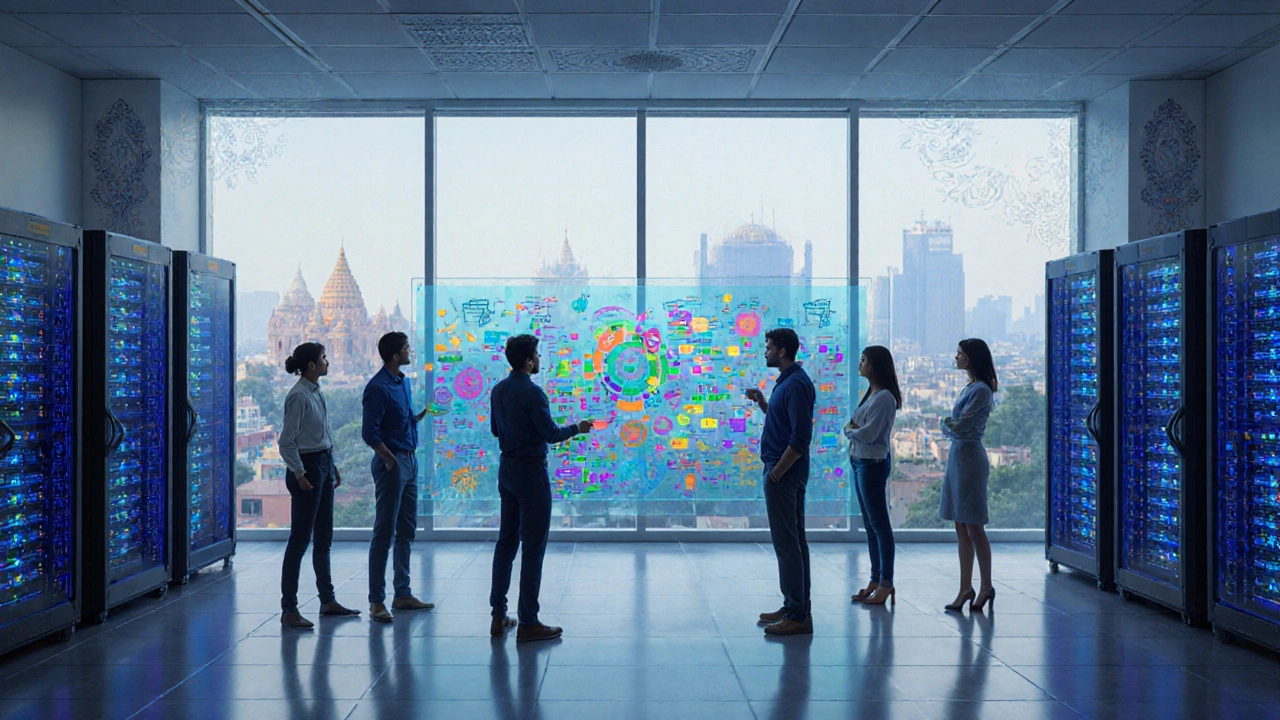Initial Training Compute Estimator
This tool estimates the compute requirements and training duration for initial training based on model size, dataset size, and hardware specifications.
Quick Takeaways
- Initial training is the first learning phase where a model extracts patterns from a large, generic dataset.
- It sets the foundation for later fine‑tuning, transfer learning, or domain adaptation.
- Key components include the training pipeline, dataset selection, hyper‑parameter tuning, and validation.
- Common pitfalls: insufficient data diversity, over‑fitting early, and neglecting proper evaluation.
- Best practice: combine robust preprocessing with scalable compute and systematic experiment tracking.
Initial training is a foundational learning stage where a machine learning model ingests a massive, often generic dataset to learn universal representations before any task‑specific refinement. It typically runs on high‑performance hardware, spans many epochs, and produces a base model that downstream developers can adapt to niche problems.
In contrast, fine‑tuning takes that base model and continues training on a smaller, domain‑specific dataset to specialize its knowledge. Understanding the split between these phases helps teams allocate compute budget, data collection effort, and timeline.
Why Initial Training Matters
Imagine teaching a child to read. You start with alphabet recognition (the "initial training"), then later teach them to read novels (the "fine‑tuning"). Without solid basics, the child struggles with advanced material. Similarly, a model that skips or rushes initial training often fails to generalize, showing high error rates when faced with real‑world data.
Data from recent industry surveys (e.g., AI2024 Workforce Report) show that 68% of successful B2B AI solutions relied on a robust initial training phase, while projects that omitted it saw a 45% increase in deployment bugs.
Core Components of the Initial Training Pipeline
Every effective initial training effort follows a reproducible pipeline. Below are the primary entities you’ll encounter, each defined with its key attributes.
- Dataset: The raw collection of examples used to teach the model. Attributes include size (e.g., billions of tokens for language models), modality (text, image, audio), and source diversity (web crawl, curated corpora).
- Model Architecture: The structural blueprint (Transformer, CNN, RNN). Key values are number of layers, hidden size, and parameter count (e.g., 175B for GPT‑3).
- Loss Function: The mathematical objective (cross‑entropy, mean‑squared error) that guides weight updates.
- Optimizer: Algorithm that adjusts parameters based on gradients (Adam, LAMB). Typical hyper‑parameter: learning rate (often 1e‑4 to 1e‑5 for large models).
- Learning Rate Schedule: Strategy for varying the learning rate across epochs (warm‑up + cosine decay is common).
- Validation Set: A held‑out slice of the dataset used to monitor over‑fitting and guide early stopping.
- Compute Infrastructure: The hardware (GPUs, TPUs, clusters) providing the raw horsepower. Metrics include TFLOPs, memory per device, and network bandwidth.
Step‑by‑Step Walkthrough
- Data Collection & Pre‑processing
- Gather a broad dataset that reflects the target domain diversity (e.g., Common Crawl for language).
- Clean the data: remove duplicates, filter profanity, normalize tokenization.
- Architecture Selection
- Choose an architecture aligned with your modality. For text, a multi‑head attention Transformer is standard.
- Set hidden dimensions, number of layers, and total parameters based on compute budget.
- Configure Loss & Optimizer
- For language models, cross‑entropy loss on next‑token prediction works well.
- AdamW with weight decay is the de‑facto optimizer; start with a learning rate of 1e‑4.
- Define Learning Rate Schedule
- Warm‑up for the first 2-5% of total steps, then decay using cosine or linear schedule.
- Launch Distributed Training
- Split the batch across multiple GPUs/TPUs. Use data‑parallelism or model‑parallelism as needed.
- Track TFLOPs to ensure hardware utilization stays above 70%.
- Monitor Validation Metrics
- Every N steps, evaluate on the validation set. Watch perplexity (for language) or top‑1 accuracy (for vision).
- If validation loss plateaus or rises, consider early stopping or adjusting learning rate.
- Checkpoint & Version Control
- Save model weights at regular intervals. Tag each checkpoint with hyper‑parameter settings for reproducibility.

Initial Training vs. Fine‑Tuning vs. Transfer Learning
| Aspect | Initial Training | Fine‑Tuning | Transfer Learning |
|---|---|---|---|
| Data Volume | Millions‑to‑billions of samples | Thousands‑to‑hundreds of thousands | Uses pretrained weights, small target data |
| Compute Cost | High (multi‑node GPU/TPU clusters) | Moderate (single‑node or cloud GPU) | Low to moderate (depends on adaptation depth) |
| Goal | Learn generic representations | Specialize for a specific task | Leverage generic knowledge for new domain |
| Typical Epochs | 10‑100+ (large models) | 1‑10 (task‑specific) | Often 1‑3 (adapter layers) |
| Risk of Over‑fitting | Low (due to data size) | High (small data) | Medium (depends on adaptation) |
Real‑World Example: Training a Large Language Model
Consider a startup that wants a conversational AI for customer support. They begin with initial training on the public Common Crawl dataset (≈ 600B tokens). Their pipeline uses a 12‑layer Transformer with 350M parameters, AdamW optimizer, and a cosine decay schedule. After 30days on a 32‑GPU cluster, the model reaches a perplexity of 12 on a held‑out validation set. They then fine‑tune on 50k annotated support tickets, achieving 93% intent‑classification accuracy. The initial training stage gave the model robust language understanding; without it, fine‑tuning would have over‑fitted the tiny ticket set.
Common Pitfalls and How to Avoid Them
- Data Leakage: Mixing validation data into the training set inflates performance. Use strict data splits and hash‑based deduplication.
- Insufficient Diversity: A narrow dataset leads to bias. Augment with multilingual or multimodal sources where possible.
- Static Hyper‑parameters: Learning rate, batch size, and weight decay often need dynamic tuning. Employ tools like Optuna or Ray Tune for automated search.
- Ignoring Gradient Clipping: Large models can produce exploding gradients. Clip at 1.0 to maintain stability.
- Poor Checkpoint Management: Overwriting checkpoints makes rollback impossible. Keep a rolling window of the last N checkpoints.
Related Concepts and Next Steps
After mastering initial training, you’ll naturally explore adjacent topics such as model quantization (reducing precision for faster inference), knowledge distillation (transferring knowledge to smaller models), and continuous learning (updating models with streaming data). Each builds upon the foundation laid during the initial training phase.
Frequently Asked Questions
What exactly is meant by "initial training"?
Initial training refers to the first, large‑scale learning pass where a model ingests a massive, generic dataset to develop broad‑range representations. It is distinct from later fine‑tuning, which adapts those representations to a specific task or domain.
How long does an initial training run typically last?
Duration varies with model size and hardware. A 350M‑parameter language model on a 32‑GPU cluster may need 2-3 weeks, while a tiny CNN could finish in a few hours. The key metric is total compute (e.g., petaflop‑days) rather than wall‑clock time.
Can I skip initial training and go straight to fine‑tuning?
Skipping is possible if you start from an existing pretrained model (e.g., BERT, GPT‑2). However, building a model from scratch without initial training usually yields poorer generalization and higher data requirements for downstream tasks.
What hardware is recommended for large‑scale initial training?
Modern GPU clusters (NVIDIA A100, H100) or TPU Pods are standard. Aim for at least 40GB memory per device to handle large batch sizes, and ensure high‑speed interconnect (NVLink, InfiniBand) to minimize communication overhead.
How do I know when to stop initial training?
Monitor validation loss and downstream task proxies (e.g., zero‑shot performance). If loss plateaus for several epochs and zero‑shot metrics stop improving, it’s usually safe to stop. Early‑stopping thresholds like "no improvement for 5 consecutive evaluations" are common.
